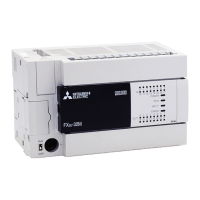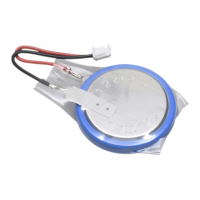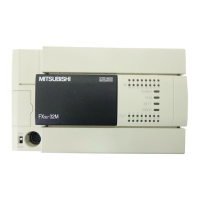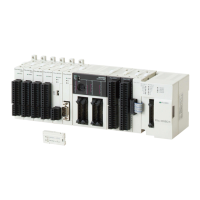Appendix C: Differences with FX2N-1PG
Appendix C-3 Differences in Operation
132
FX3U-1PG User's Manual
Appendix C-3 Differences in Operation
Appendix C-3-1 Differences in properties common to all operation modes
Differences in properties common to all operation modes of FX3U-1PG and FX2N-1PG are shown in the
following table.
*1. It is controlled inside the FX
2N-1PG.
Change point FX3U-1PG FX2N-1PG Replacement point
Output frequency
The output pulse frequency (f) of
FX3U-1PG is stepwise as follows.
f = 24 × 10
6
/ n (Hz)
Where, n: Integer in range of 120 to
24,000,000
Example:
When the operation speed I is set
to "99,000 Hz"
99,000 = 24 × 10
6
/ n
n = 24 × 10
6
/ 99,000
= 242.4 (Rounded off)
242
When the "n = 242"
Output pulse frequency
f = 24 × 10
6
/ 242
= 99,174 Hz
The output pulse frequency (f) of
FX
2N-1PG is stepwise as follows.
f = 1 × 10
6
/ 0.25n (Hz)
Where, n: Integer in range of 40 to
400,000
Example:
When the operation speed I is set
to "99,000 Hz"
99,000 = 1 × 10
6
/ 0.25n
n = 1 × 10
6
/ 0.25 / 99,000
= 40.4 (Rounded off)
40
When the "n = 40"
Output pulse frequency
f = 4 × 10
6
/ 40
= 100,000 Hz
The actual output frequency may be
different even if the same operation
speed I is set as shown in the
example on the left because the
stepwise property of the output
frequency is different.
Confirm that no problem is expected
in the system.
Change the sequence program as
needed.
The frequency which can be output
from the FX
2N-1PG can be output
also from the FX3U-1PG.
Accordingly, by setting the actual
output frequency of the FX2N-1PG
in the FX3U-1PG, the motor can
operate at the same speed using
the FX3U-1PG.
Starting time
Motor system: 1 ms or less
Machine system: 2 ms or less
1st time: 500 ms or less
2nd time and later: Approximately
10 ms
Confirm that that the difference in
the starting time causes no problem
in the system.
Change the sequence program,
such as setting up starting delay
time (BFM#16) if needed.
Operation when the PLC mode
changes from RUN to STOP
Continues the positioning
operation.
The motor decelerates and stops.
However, the motor continues the
operation if the FROM/TO
instruction, etc. is being executed
by the BFM monitoring function,
etc.
When the positioning operation is
stopped by the PLC mode change
from RUN to STOP, change the
sequence program so that the
positioning operation is stopped by
the STOP signal (BFM#25 b1 or
STOP terminal).
Operation
command
(BFM#25)
STOP detection
(BFM#25 b1)
Level detection.
It is necessary to keep the STOP
signal ON for 1 ms or more.
Edge detection.
When the STOP is set to "OFF →
ON → OFF" in less than 1 ms,
change the sequence program so
that the STOP remains ON for 1 ms
or more.
Forward limit/
Reverse limit
(forward pulse
stop or reverse
pulse stop)
Operation when
the forward limit
or reverse limit
(forward pulse
stop or reverse
pulse stop) is
detected in the
operation
direction
The operation varies as follows
depending on the setting of the
limit deceleration mode (BFM#3
b11 or BFM#37 b11):
• When the limit deceleration
mode (b11) is OFF
The motor stops immediately,
and the FX3U-1PG outputs the
CLR signal.
• When the limit deceleration
mode (b11) is ON
The motor decelerates and
stops, and the FX3U-1PG does
not output the CLR signal.
In either mode, the forward limit/
reverse limit error (Error code: K6)
occurs after the motor stops.
The motor stops immediately, and
the FX2N-1PG outputs the CLR
signal.
No error occurs.
In a sequence program that detects
errors and then performs a specified
action, confirm that no problem is
expected when the forward limit/
reverse limit error occurs.
Change the sequence program as
needed.
Changing the
current address
Operation when
the value written
to the current
address
(BFM#27, #26) is
equal to the
current value
The current address (pulse
converted value) (BFM#59, #58)
will not be updated.
The current address (pulse
converted value)
*1
will be updated.
If the value written to the current
address (BFM#27, #26) is equal to
the current value, change the
sequence program so that the value
written will be converted to a pulse
converted value and written to the
current address (pulse converted
value) (BFM#59, #58).

